#ancient Macedonian religion
Explore tagged Tumblr posts
Note
Hi Dr. Reames. I was just wondering, as someone who has been looking into Hellenism, how exactly were Alexander and Hephaestion (though I'm more interested in Hephaestion) worshipped? Little details that we know of, like, what kind of particular offerings were left at their altars? What kind of rituals were performed? Festivals? Was their worship intertwined? As a rebellious Gay maybe I'm looking to join lol. Anyway, much love, a history buff that appreciates your work. 👍
Worshiping Hephaistion and Alexander
Hephaistion was named a “hero,” which means he’d have received typical heroic worship in a heroön, or hero shrine. Usually, these were modest, but the one planned for him in Alexandria was quite stupendous. The one in Pella where the dedicatory plaque from a certain Diogenes (SEG 40:547: Διογένης Ἡφαιστίωνι ἥρωι—Diogenes to Hero Hephaistion), was possibly also more sizable. Vouturas (who published the dedication)* thinks it was to the north or west of the acropolis and palace complex, maybe in a cave, although I don’t know of any caves there. If there were others elsewhere, they were probably more typical.
Anyway, hero worship was highly individualized by region and even city and family. Making any certain claims is virtually impossible, but as a heroön, the (flat) altar would likely be inside although the architecture of shrines could vary, as noted. The altar might also have a hole in the middle for blood (or other fluid such as wine or oil) offerings to be sent down into the earth for the dead person. (In contrast, ouranic [sky deity] altars were always outside and raised.)
Blood offering for heroes were small, dark/black animals, such as cockerels (especially popular as a psychopomp), rabbits, piglets, small game birds, puppies, etc. These would be killed and the blood drained on the altar (into the hole if one was there), then the whole sacrifice would be burnt (or buried). That’s why such offerings were typically small. The average person couldn’t afford to waste a large animal. (The oath in book 2 Rise, of Dancing with the Lion, features a blood sacrifice at the hero shrine of Iolaos outside Thebes. So that describes a rite for you, albeit a rather specific one.)
But blood sacrifices were more expensive. Much more common were bloodless sacrifices. In fact, bloodless sacrifices were THE most common sort and might be combined with a blooded sacrifice. Bloodless sacrifices were usually a libation of wine/oil/honey/milk/spring water, or incense offered on the altar, or special little cakes baked and left in the offering patella, or small cup/platter that might be in the hand of the hero’s image….
…just like you see below on the dedicatory plaque. The woman is pouring a libation (likely wine) into the patella being held by “Hephaistion.” She also has a little round pottery jar that likely contained incense, also to be offered. These are both super standard. It’s like going into an Orthodox or Catholic church and purchasing a candle to light before an icon or other image and placing it in the sandbox. Dedications could also be more personal, depending on circumstance. A lock of hair, a memento, a toy…etc.

Hero worship was a weird thing. And, as noted, highly individualized to a region. Heroes were usually connected to something specific. For instance, Hephaistion’s name was to be used in Egypt in mercantile contracts. I find this intriguing. But just as saints are typically the “saint of…” so also with heroes, who oversaw ___. Most of the time, these were mythical figures, although the founder of a colony (oikistes) received hero cult after his death. By the early 4th century, we also see some historical people included. Heroization of Macedonian kings after their deaths may also have been a thing, but that’s more speculation than certainty.
Later evidence suggests that cult for real, historical people as opposed to mythical people in the distant past never really gained a huge foothold. Even “worship” of Hellenistic kings and Roman emperors was more pro-forma and patriotic than actual. Now, keep in mind that the heroes I’m calling “mythical” were absolutely believed to be real people by the ancients. But they lived “way back then” in a “different time” (the Age of Heroes) and so had a special patina that Joe Average Greek (even a Very Important Person) never quite acquired.
One of the rare exceptions to that was Alexander. Hephaistion…not so much. His cult probably didn’t much outlive Alexander himself.
Diogenes dedicatory plaque was made in the last quarter of the 300s…e.g., just shortly after Hephaistion’s death. It’s the only one of its kind, and may have been purchased shortly after Hephaistion died but before word of Alexander’s own death reached Pella. E.g., Diogenes might have been trying to earn brownie points from whatever officials there in Pella would notice his piety, and pass on news of it to Alexander. It’s nice but middling in cost, with nothing distinctive about it. E.g., the figure (Hephaistion) is a generic hero horseman of a type we often see in the north (See image below, a grave stele from Thessaloniki area, Roman era), plus a generic female worshiper. The fact the dedicator was a man, but it’s a woman on the plaque leads me to conclude it was pre-carved. These dedicatory figured plaques and tombstones took so much time, many were pre-carved. So that probably is not what Hephaistion looked like. The plaque has been damaged on the left and may once have included a tree, perhaps with a snake in it, which would be standard imagery. That may be the edge of the trunk we can see behind the horse’s rear leg and tail. (For a whole lot more, go HERE; I've seen tons of these Hero Horsemen in museums in both north Greece and Bulgaria.)

After his death, Alexander did receive cult much more in line with godhood (if not on the same level as Zeus), akin to what Herakles might have received. As he was human (and died), the sacrificial animals would have been dark, not light (as for an ouranic, or sky deity). The Ptolemies instituted an entire cult centered on Alexander worship, in fact, which no doubt helped solidify his elevation into true cult status. It also helped the Ptolemies’ claim on power. 😉
As for whether sacrifices were made to Hephaistion along with Alexander—hard to say. It wasn’t at all unusual for Greeks to combine the worship of related deities. For instance, when sacrificing to Apollo, one might also sacrifice to Leto, and/or Artemis. But it wasn’t assumed, and the Ptolemies, who promoted the cult later, had no real reason to promote Hephaistion’s too. We lack record of a temple to Alexander that also included a heroön to Hephaistion, but there could well have been one, certainly in Alexandria. Or in Pella. (Greeks allocated a shrine to each deity, even if they might be constructed inside the same temenos, or sanctuary.) Yet worship of Alexander wasn’t encouraged by Kassandros, nor by the Antigonids later. In fact, the royal cemetery at Aigai fell out of use for centuries after the burial of the last Argeads. So cult to Alexander (and Hephaistion) appears to have been more limited in Macedonia itself.
I’ve discussed worshiping Alexander in a YouTube video, linked below.
youtube
----------------------------------
*Emmanuel Vouturas, “Ηφαιστίων ήρως.” Εγνατία 2 (1990): 123-173.
#asks#Hephaistion#Hephaestion#ancient Greek religion#ancient Macedonian religion#Alexander the Great#Ptolemaic Empire#cult for Alexander the Great#cult for Hephaistion#hero cult in ancient Greece#Classics#Hero the Horseman#ancient Greece#tagamemnon
29 notes
·
View notes
Text

Alexander Consulting the Oracle of Apollo by Louis-Jean-François Lagrenée
#louis jean françois lagrenée#art#alexander the great#oracle#apollo#statue#classical antiquity#ancient greece#ancient greek#macedon#macedonia#macedonian#pagan#paganism#europe#european#history#incense#religious art#religion
166 notes
·
View notes
Photo

Ancient Armenia, located in the south Caucasus area of Eurasia, was settled in the Neolithic era but its first recorded state proper was the kingdom of Urartu from the 9th century BCE. Incorporated into the Persian Empire of Cyrus the Great in the 6th century BCE, the Orontid dynasty ruled as Persian satraps, a function they performed for their next overlords the Macedonians and Seleucid Empire into the 3rd century BCE. Under the Artaxiad and Arsacid dynasties the country flourished but was often caught between the ambitions of Parthia and Rome, and then the Sasanian and Byzantine Empires. The boundaries of the state varied considerably over the centuries but such common factors as religion and language were united by long-lasting dynastic clans, which gave Armenia its own unique identity throughout antiquity.
145 notes
·
View notes
Text
The Roman Pharaohs of Ancient Egypt
In ancient history the pharaoh was the head of state and ruler of the country. However, he was not just a secular ruler, but a divine being on Earth who acted as an intermediary between the spiritual world and the earthly world. In essence he was a mortal representative of the gods. Interestingly, one did not have to be an Egyptian to be an Egyptian pharaoh. The act of conquering and ruling Egypt qualified one to be a pharaoh. As a result there were many foreign pharaohs throughout Egyptian history including those who were Persian, Nubian, Libyan, Hyksos, Kushite, and Macedonian Greek.
In 30 BC Cleopatra VII became the last ruler of Egypt from the Macedonian Greek Ptolemaic Dynasty. Cleopatra had backed the losing side of a Roman civil war, opposing Octavian and supporting Marc Antony. Octavian won, she was deposed, she committed suicide, and Egypt became a Roman province. When Octavian became Augustus and founded the Roman Empire, the Egyptians also recognized him as the official Pharaoh of Egypt. Afterwards successive Roman emperors were also declared pharaohs, until around the 4th century when Christianity became the dominant religion in Egypt.
Truth be told, most if not all Roman emperors didn't give a damn about being pharaohs. Most emperors never even stepped foot in Egypt and it didn't seem like they took their role as pharaoh very seriously. Regardless Egyptian iconography and art was crafted depicting Roman emperors in Egyptian style wearing Egyptian royal regalia and interacting with Egyptian gods. Some interesting examples are...
Gigachad Pharaoh Augustus
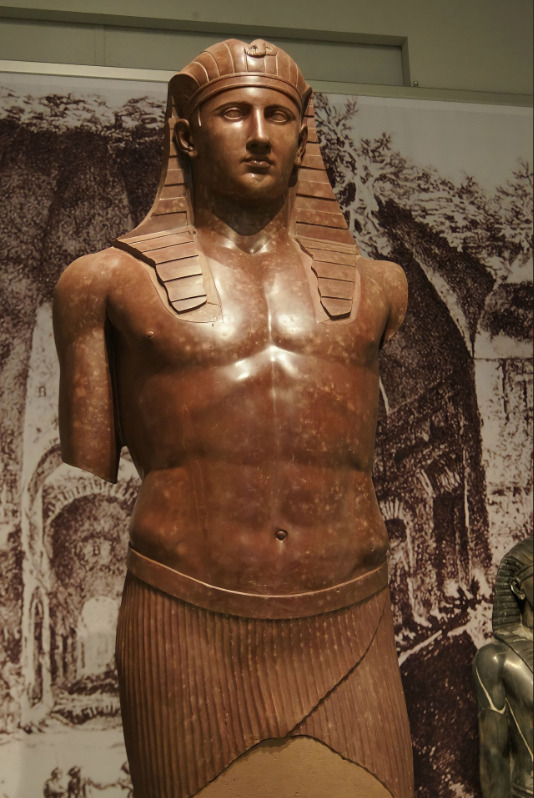
Tiberius
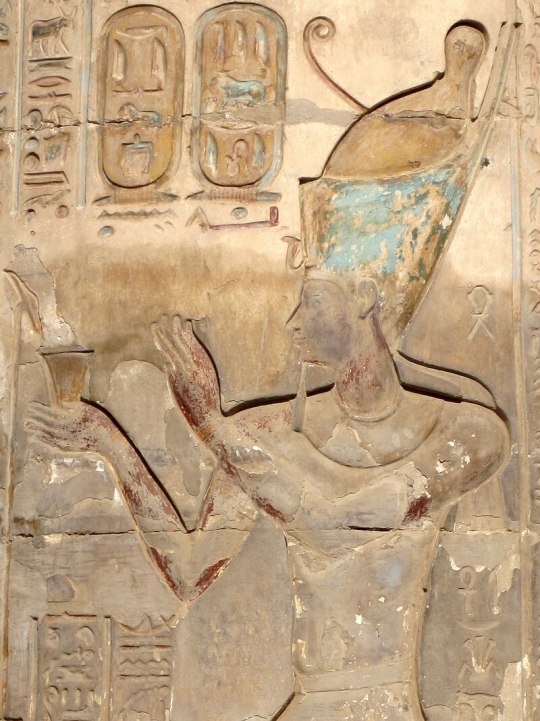
Nero
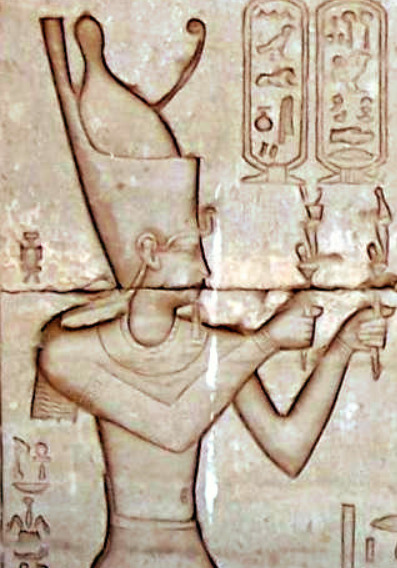
Nero again

Trajan making sacrifices to Hathor

Domitian
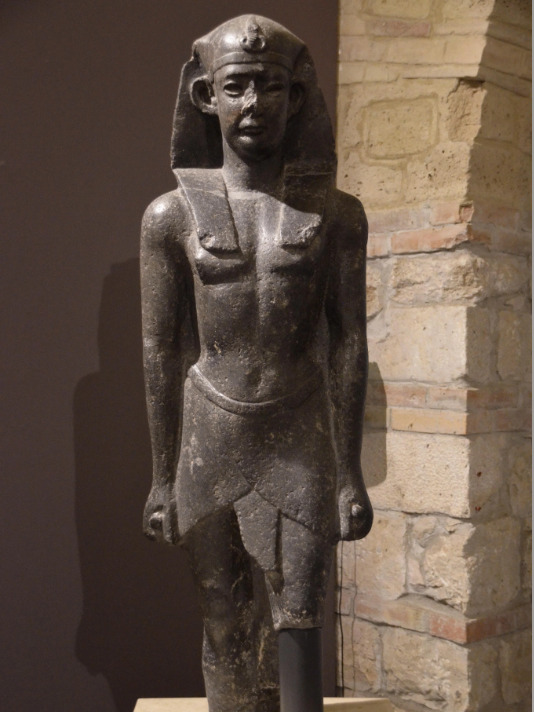
Domitian with Horus
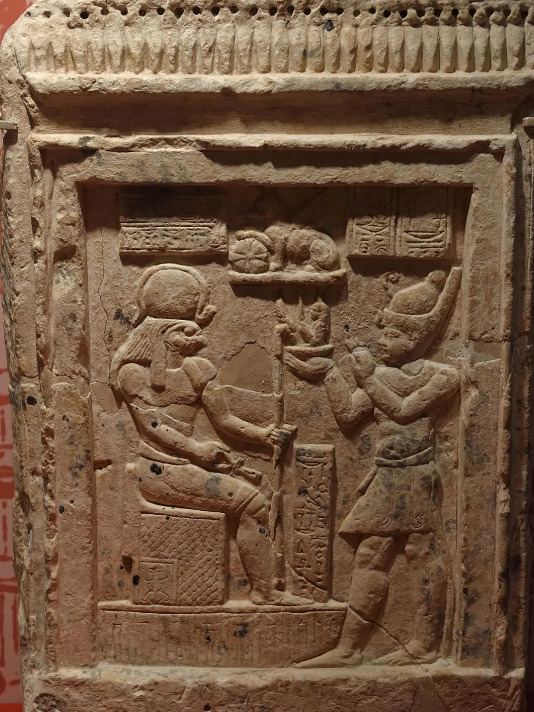
Caracalla
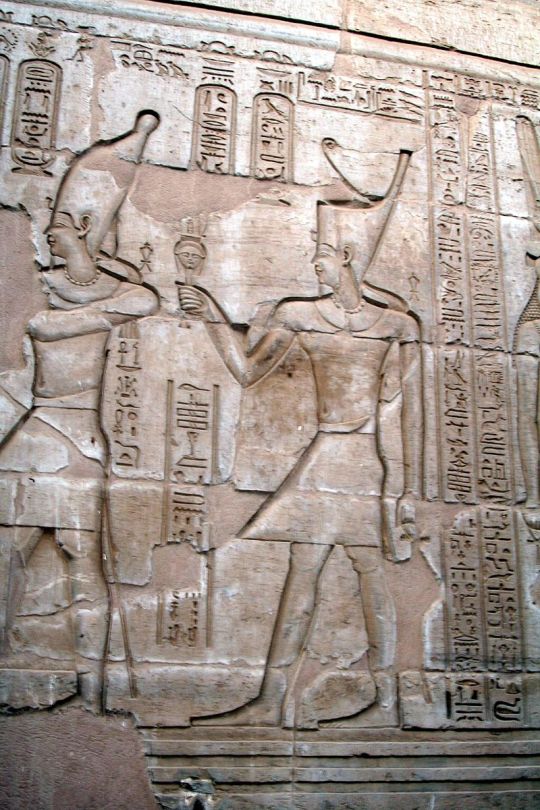
Marcus Aurelius

173 notes
·
View notes
Text
Pluto might be in Aquarius
But that's only half the story.
Now I'm not one to believe only the planets inspire change in people but the environment they live in, their disposition and their current state of being impacts them just as much. Astrology without the consideration of culture and context is just astronomy. It has the body but not the soul.
I start with that because of all the current global happenings. I understand the importance of spiritual and religious practices, and they don't exist in a bubble of their own. It is highly related to the cultural movements and ethnic practices of a region. If we are going to be honest religions/spirituality would not exist with out those cultural foundations. Literally there would be nothing if ethnic and cultural differences didn't play a role.
Hoodoo wouldn't exist if African Americans didn't. The Greek Pantheon wouldn't be a thing if the ancient Greeks didn't interact with the Egyptians, Nubians and Macedonians. And it should be very well known the Romans stole their whole flow and rebranded. The same Romans who took Christianity and set the foundation for the many versions we see today.
I say all that because I've noticed a lack of connecting between the social/political climate, traditions and belief systems. We can't pretend that Vedic astrology isn't an actual part of Hinduism because it wouldn't exist if Hinduism wasn't here. And Hinduism is the result of two very different populations interacting with one getting colonized and pushed south and the other needing a system/ belief to justify it. We can't pretend that tropical astrology isn't a more Eurocentric method because the signs, planets and their meanings are not the same outside of Western/Eurocentric ideology. In fact it's heavily based off of Roman and Greek interpretations, the base of Western Society as a whole.
I'm not going to pretend that Pluto moving into Aquarius is the only reason why we suddenly "see" more social changes, more standoffish behavior, more coldness to our fellow human. All Aquarius is doing is putting it on the internet. It sent a tweet out and we all saw it. These issues aren't a magical happening, they are the result of centuries of bs pilling up. Of cultures merging in ways that weren't possible before modern technology. Of colonization. Imperialism. Chattel Slavery. The Arab Slave trade. Ethnic cleansings.
People weren't passive before the shift into Aquarius, people were ignoring it. It's really easy to do when you have no personal reason to care, in fact it's probably something all humans can relate to on one topic or another. Trust me I was heavily into activism spaces a decade ago, everything being talked about in media now was talking about then. It was talkes about when my parents were growing up in the 60s. My grandparents in the 20s/30s and so on. Aquarius just put it in our faces (again, and will continue to do so) and said "now what? ".
I want people to not just lean in to spiritual/religious practices because they are popular but to look into the actual meanings they have. I want people to understand that yes you can be spiritual/religious and your ethnic background does impact how you practice. I want people to understand these changes we see in France (they lost their standing in Africa, literally all their former colonies told it to cope, and that's leading to their collapse), South Korea (this is not the first, and sadly won't be the last time, power has been abused under the name of "anti communism", in fact ask South East Asians how they treated there and you'll see this was going to happen), the United States (a country founded on genocide and racism isn't going to magically be less of those because a Black woman got to run for office) etc aren't solely a shift in the Star positions.
I see people point out the French Revolution happened the last time Pluto was in Aquarius (but they also had lost all the land in the US and Haiti told them to fuck off, so it wasn't just not eating cake, it was the lack of slave labor to fund their empire). Or America getting it's freedom (Britain was getting close to abolishing chattel slavery (again free labor, people hate to lose their free labor), the Irish and Scottish were also giving the English a hard time, they had to pick between the people next door or the ones over the Ocean). At that time it was the lack of free labor that pushed those movements, yeah everyone didn't have slaves but they all benefited from that system.
So many astrologers say don't let the stars determine your life but literally turn around and do that. Astrology is a tool at the end of the day. That's it, because if someone doesn't believe in it that doesn't change what happens. Conformation bias would have us believe differently but that's just part of our nature to lean towards that which supports us, not questions us. It's a practice that spans the globe and millennia because we can all look up and see the same stars at night. Maybe not as bright because light pollution, not the same positions because stars go supernova and the solar system moves, but it's still up for everyone on the planet. It's something that regardless of where you go, there's some meaning to it, maybe not always spiritual but a reason nonetheless. And it's never the same, obviously or else this would be a very boring plane of existence, and there's overlap because humans gonna human no matter where we are.
I implore you to think on your upbringing. Think on your ethnic group(s). Think on your current country of residence. Think on what you were taught in school. Think on your family. Because that's what's impacting you. That's what makes you make the decisions you do. Not just Mars moving through your third house (this is just an example, if that's happening for you good for you or I hope it gets better idk) .
Pluto in Aquarius isn't bring change. It's humans and our individual motives that are and always have.
Aquarius is a sign that puts the spot light on things already in motion. It makes you think because if you don't you can't understand. It makes you detached because if you feel it too much you might get hurt. It makes you remember because this isn't the first, nor the last time it will happen. Aquarius is the personal motive made public part of human nature. The selfish desires that push for survival. The seeking of like mindedness. The drive for community, but only if it's the same as you. Aquarius is the when of the story.
#astro tumblr#nymph might piss people off and thats cool#Aquarius#pluto in aquarius#nymph writes astrology#astroblr#pluto is transiting my 1st/12th house. can you tell#astrology
26 notes
·
View notes
Text
Uncertainty surrounds nearly every aspect of Olympias’ public life in the period from Alexander’s departure till his death. Her private life is another matter. Mother and son certainly remained in communication. In many respects, they acted as a conventionally devoted and doting mother and son. Alexander sent booty home to Olympias (FGrH 151 F 1; Plut. Alex. 25.4). She made an offering at the shrine of Hygieia in Athens, probably for her son’s health (Hyp. Eux. 19), and arranged for splendid offerings at Delphi (SIG I 252N 5ff., with n.3), probably funded from the plunder Alexander had given her. Ancient sources plausibly insist that they maintained a regular and considerable correspondence and tend to mention their letters when the contents are political, but much of it may have had to do with mundane family affairs.
Olympias’ public role, in Macedonia, Molossia, and Greece, was far less conventional and proves much harder to categorize. To what degree did her son authorize her role and to what degree did she take advantage of Alexander’s long absence for her own aggrandizement? Lack of clarity about her physical location, position, power, and authority vis-à-vis both her daughter Cleopatra and Antipater, Alexander’s general, further complicates these questions.
Though Antipater exercised supreme military control over Macedonia and Greece during Alexander’s absence, Olympias exerted considerable public authority as well. Alexander may not have defined their duties and spheres of influence before his departure; Macedonian offices in general—if they existed at all—seem undefined at this period and Olympias probably held no office as such anyway. Alexander’s failure to define the roles of Olympias and Antipater would cause problems, ones Alexander chose not to resolve. Granted the military aspect of Antipater’s role, the fact that no woman had ever acted as sole substitute king in Macedonia, and the absence of a clearly defined office of regent, Olympias’ actions were not motivated by a frustrated desire to be regent. Her public role had three sources: her personal relationship with her son, a relationship that inevitably led others to see her as, to some degree, Alexander’s agent; her membership in the royal dynasty, in whose axioma (reputation) and religious sanction she shared; her membership in the Aeacid dynasty of Molossia, whose rule she shared and whose traditional alliances may have worked to her benefit. While these three sources of power always mattered, they came to matter more as the years of Alexander’s absence increased.
Many signs indicate Olympias’ public power, despite the fact that Plutarch (Alex. 39.7) claimed that Alexander did not allow her to interfere in his affairs or military matters. The second part of Plutarch’s claim, however, may have been correct. Although Olympias certainly did play a military role after Alexander’s death, […] we know of no such activity during her son’s reign. Military matters apart, however, Olympias certainly did “interfere” (it is not clear, as we shall see, that Alexander would have understood it as interference) in her son’s affairs. She (and her daughter) not only played a role in the internal politics of their two kingdoms, but also participated in international diplomacy. The prominence of women, particularly elite women, in Greek religion has been understood in terms of piety and conventional gender roles, despite the fact that, in the Greek world, international ties were often created, maintained, or, at the very least, interpreted in terms of religious ties. Female involvement in international religious activities should therefore be understood as diplomatic activity as well.
[...] Olympias and her daughter performed benefactions of international scope, actions much more public in nature than Olympias’ temple dedications. Such benefactions had a diplomatic aspect since they could initiate or confirm a relationship between benefactor and recipient. Her name and Cleopatra’s (each without either a patronymic or a reference to Alexander) appear on a list of major recipients of grain from Cyrene (SEG IX.2). In fact, Olympias’ name appears twice, most likely as a recipient of grain for Macedonia. This grain was probably not a free gift, but bought by those listed at the usual rather than famine price, perhaps to keep prices low despite the shortage. All the other names on the list belong to states, but only the personal names of Olympias and Cleopatra appear. Parallel male usage suggests that the two women were functioning as heads of state. As is often the case with acts of female benefaction (euergetism) or piety, we cannot be certain whether Olympias paid for this grain on her own initiative, with her own funds, or whether she and her daughter were merely Alexander’s agents. Even if Alexander had privately ordered and funded his mother’s benefaction, the inscription highlights her role and omits any mention of her son. Antipater performed no action so formally authoritative as the role of mother and daughter commemorated in the inscription.
Other indications of Olympias’ international role exist. Hyperides, a contemporary orator, pictures Olympias and Alexander (apparently jointly) inflicting harm on the Athenians, and he makes a similar link between the interests of Olympias and the Macedonians (Hyp. Eux. 20). On the other hand, Hyperides also reports that Olympias, apparently speaking in her own interest, stated that Molossia belonged to her (Hyp. Eux. 25; [...]). Diodorus (17.108.7) claims that Antipater and Olympias (whether in concert or in opposition to each other is unclear) demanded that the Athenians extradite Harpalus, Alexander’s absconding treasurer. Conceivably, control of the money Harpalus had taken with him motivated either or both. Antipater and Olympias may each have been eager to dissociate themselves from Harpalus and the dual request may also reflect concern (on their part or Alexander’s) to reach various Athenian political factions. Alexander’s Exiles’ Decree (Diod. 18.8.4), with its threat that the Athenians would have to return Samos, would have made Antipater a controversial figure in Athens. At this moment, Olympias may have had wider appeal there. Her popularity in Athens doubtless varied with the period and the sources’ politics. Hyperides, for instance, notoriously anti-Macedonian, speaks of Athenian hatred of Olympias, but in a context that tends to depersonalize the sentiment, associating it with resentment of Macedonian influence in general (Eux. 20–1). On the other hand, perhaps in part because of the Aeacids’ traditional friendship with them [...], the Athenians sometimes saw her too as a friend. Diodorus (18.65.2), speaking of a period after the death of Alexander, comments that they had always respected her and her previous honors and now hoped that she would help them to restore their autonomy.
— Elizabeth D. Carney, Olympias: Mother of Alexander the Great
#Olympias#macedonian history#greek history#ancient history#women in history#alexander the great#Kleopatra of Macedon#my post
6 notes
·
View notes
Text
Ptolemaic Gondor?
Tolkien named Ancient Egypt as one of the inspirations for Gondor-particularly aesthetically and in their capacity for grand architecture. The crown of Gondor also resembles the crown of Upper Egypt, tall and conical, with similar symbolism between the combining of the crowns of Upper and Lower Egypt and the combination of the Gondorian crown with the Arnorian diadem-the Elendilmir. I think there is also a deeper link between Gondor and Ancient Egypt, particularly Egypt under the Ptolemaic dynasty, the last to rule Egypt before the Romans annexed it.
Under the cut for a brief history of Ptolemaic Egypt and what that has to do with Gondor!
The Ptolemies were descended from one of Alexander the Great’s generals, called, unsurprisingly, Ptolemy. Alexander and his army were from Macedon, a northern Greek kingdom. In the chaos after Alexander’s death his generals carved up his empire, with Ptolemy rushing to Egypt and having himself proclaimed Pharaoh. The Ptolemaic dynasty ruled from Alexandria, a city founded by Alexander in the Nile delta, on the shores of the Mediterranean. Ptolemy was a Macedonian, and many other Macedonians, both soldiers of Alexander and others, followed them to Egypt. Alexandria became a great centre of Greek Hellenic culture dominated by Macedonians, who became basically a ruling class of this new Ptolemaic state. The highest offices of government were reserved for Macedonians, Macedonian Greek was the court language, the military was made up (at first at least) of Macedonians and mercenaries, with no recruitment from the Egyptian population. The traditional Egyptian religion and the role of the Pharaoh within it remained (with some Greek introductions), but in most other things Macedonians and their customs dominated. No Ptolemaic Pharaoh even knew how to speak Egyptian until Cleopatra VII (yes, that’s THE Cleopatra), the last ruler of the dynasty! Even she seems to have done little to better integrate Egyptians and Macedonians, with the Macedonians remaining firmly in charge until the Romans annexed Egypt.
Now the Ptolemies were not the only successors of Alexander, and one of their main rivals were the Seleucid empire, founded by fellow Macedonian general Seleucus. The Ptolemies often fought for control of the Levant in the Syrian wars. During the reign of Ptolemy IV the Ptolemies and Seleucids were embroiled in the fourth Syrian war. Faced with manpower shortages within the Macedonian ruling class, Ptolemy IV’s army included Egyptians trained to fight in the Macedonian style as part of the phalanx. At Raphia, Ptolemy IV won a decisive victory, with the Egyptian troops playing a key role in the battle. While this did improve the lot of Egyptians within Ptolemaic Egypt, Macedonians continued to dominate both the state and the military, and the failure to further integrate Egyptians into the army contributed to the weakening of the Ptolemaic state, which enjoyed arguably its finest hour at Raphia. A succession of poor rulers and civil war would see the state decline, eventually being annexed into the Roman empire after the death of Cleopatra VII.
Now, how does that fit with Gondor?
Gondor was founded by Númenorian exiles, with a Númenorian ruling class. Its main languages are Westron (descended from Númenorian Andunaic) and Sindarin, a common language among certain Númenorian communities. Comparisons may be made between Alexandria and cities like Pelargir and Osgiliath as centres of Númenorian dominance and culture (Pelargir especially, there is a reason Castamir liked it so much). And, like Ptolemaic Egypt, it seems like Númenorians dominated the military, with other peoples excluded. To quote Faramir:
“But the stewards were wiser and more fortunate. Wiser, for they recruited the strength of our people from the sturdy folk of the sea-coast, and from the hardy mountaineers of Ered Nimrais.”
This would seem to imply that prior to this, these peoples were excluded, and Númenorians dominated the military. But the Gondorians learned their lesson, at least to a greater degree than the Ptolemies did, and were able to slow their decline by better integrating non-Númenorians into the state. Númenorians still hold the highest positions of power (Denethor and Imrahil are the two most powerful men in the country in the late third age, both are Númenorians), but military discrimination is at least heavily reduced.
The appendices and unfinished tales do say that Northmen were recruited into the Gondorian military after the Kin-Strife, and mentions them in Eärnur’s army sent to fight Angmar. These may have been analogous to the mercenary forces used by the Ptolemies, rather than representing a widening of recruitment (though many Northmen did settle in Gondor after the Kin-Strife).
Obviously the comparisons are not 1:1, but I think early Gondor may well have resembled Ptolemaic Egypt in the structure and stratification of society. I suspect that this began heavily breaking down after the Kin-Strife. For a start, a lot of Númenorians are dead, or have been forced to renounce their ancestry by Eldacar. The Gondorians will need to look elsewhere for a supply of manpower. Númenorian supremacy may well start being seen as treasonous due to Castamir’s actions, and an active threat to the continued existence of the Gondorian state. By Denethor II’s time the Gondorian army seems far more diverse, and even many of the aristocrats may well be non-Númenorian (though again, Denethor and Imrahil occupy the most powerful positions).
#gondor#lotr#lotr meta#my posts#I've seen people compare Númenorian imperialism to modern imperalism like that of the european states from 1600-1900s#While I think that fits for Númenor I don't think it quite works for Gondor#Ptolemaic-like Gondor seems to fit much better with how this society works-it's very much not like anything from the modern period to me#also apologies if I made any historical mistakes#I'm not a historian or an expert on ptolemaic egypt to feel free to correct me if I got anything wrong#I just think ptolemaic egypt is an interesting comparison for what we know about gondor
35 notes
·
View notes
Text
D.U.D.E Bios: Sabina Volkov
Ardalion's Wife Sabina Volkov (2020)

The wife of Ardalion and sister-in-law of Pelageya, Sabina.
"Poveselimsya!"
Name
Full Legal Name: Sabina Vera Volkov (Née Melnik)
First Name: Sabina
Meaning: Feminine form of 'Sabinus', a Roman cognomen meaning 'A Sabine' in Latin.
Pronunciation: SA-bi-na
Origin: Italian, Spanish, Portuguese, Romanian, Polish, Czech, Slovene, Russian, Croatian, Swedish, Ancient Roman
Middle Name: Vera
Meaning: Means 'Faith' in Russian, though it is sometimes associated with the Latin word 'Verus' 'True'.
Pronunciation: VYEH-ra
Origin: Russian, English, German, Swedish, Norwegian, Danish, Dutch, Portuguese, Italian, Spanish, Hungarian, Romanian, Slovene, Serbian, Croatian, Bulgarian, Macedonian, Belarusian, Georgian
Surname: Volkov (Née Melnik)
Meaning: Volkov: Patronymic derived from Russian 'Volk' meaning 'Wolf. (Melnik: Means 'Miller' in Russian.)
Pronunciation: vul-KOF (MYEHL-nyik)
Origin: Russian (Russian)
Alias: None
Reason: N/A
Nicknames: Verochka, Verusha, Verusya
Titles: Mrs, Ma'am
Characteristics
Age: 31
Gender: Female. She/Her Pronouns
Race: Human
Nationality: Russian
Ethnicity: White
Birth Date: March 9th 1989
Symbols: None
Sexuality: Straight
Religion: Russian Orthodox
Native Language: Russian
Spoken Languages: Russian
Relationship Status: Married
Astrological Sign: Pisces
Theme Song (Ringtone on Geia's Phone): 'Roza Lyuksemburg' -Mumiy Troll
Voice Actor: Eugenia Kuzmina
Geographical Characteristics
Birthplace: Bolgar, Spassky District, Republic of Tatarstan, Russia
Current Location: Bolgar, Spassky District, Republic of Tatarstan, Russia
Hometown: Bolgar, Spassky District, Republic of Tatarstan, Russia
Appearance
Height: 5'5" / 165 cm
Weight: 145 lbs / 65 kg
Eye Colour: Brown
Hair Colour: Brown
Hair Dye: None
Body Hair: N/A
Facial Hair: N/A
Tattoos: (As of Jan 2020) 8
Piercings: Ear Lobes (Both)
Scars: None
Health and Fitness
Allergies: None
Alcoholic, Smoker, Drug User: Social Drinker
Illnesses/Disorders: None
Medications: None
Any Specific Diet: None
Relationships
Allies: N/A
Enemies: N/A
Friends: N/A
Colleagues: N/A
Rivals: None
Closest Confidant: Ardalion Volkov
Mentor: Svetlana Melnik
Significant Other: Ardalion Volkov (30, Husband)
Previous Partners: None of Note
Parents: Timur Melnik (51, Father), Svetlana Melnik (52, Mother, Née Medved)
Parents-In-Law: Rudyard Volkov (53, Father-In-Law), Diana Volkov (54, Mother-In-Law, Née Shvets)
Siblings: Taras Melnik (28, Brother), Susanna Melnik (25, Sister), Svyatoslav Melnik (22, Brother), Rada Melnik (19, Sister), Stanislav Melnik (16, Brother), Oktyabrina Melnik (13, Sister), Saveliy Melnik (10, Brother), Noyabrina Melnik (7, Sister), Rudolf Melnik (4, Brother)
Siblings-In-Law: Pelageya Winter (33, Ardalion's Sister, Née Volkov), Matrona Volkov (27, Ardalion's Sister), Yaroslav Volkov (24, Ardalion's Brother), Klavdia Volkov (21, Ardalion's Sister), Wassily Volkov (18, Ardalion's Brother), Oxana Volkov (15, Ardalion's Sister)
Nieces & Nephews: Nathan Winter (33, Nephew), Genesis Winter (34, Nathan's Wife, Née Rivers), Zinnia Turner (30, Niece), Patrick Turner (31, Zinnia's Husband), Laurence Winter (27, Nephew), Xanthia Winter (24, Niece), Joseph Winter (21, Nephew), Venetia Winter (18, Niece), Isaiah Winter (15, Nephew), Uliana Winter (12, Niece), Emil Winter (9, Nephew)
Children: Feliks Volkov (10, Son)
Children-In-Law: None
Grandkids: None
Great Grandkids: None
Wrestling
Billed From: N/A
Trainer: N/A
Managers: N/A
Wrestlers Managed: N/A
Debut: N/A
Debut Match: N/A
Retired: N/A
Retirement Match: N/A
Wrestling Style: N/A
Stables: N/A
Teams: N/A
Regular Moves: N/A
Finishers: N/A
Refers To Fans As: N/A
Extras
Trivia: Nothing of Note
2 notes
·
View notes
Text
Just out. Yes, it's stupid-expensive, but perhaps you can get your local library to get a copy.
This is the second important collection on ATG out this year, and which I have a chapter in. I'm rather proud of my material in both the Cambridge Companion to Alexander the Great (which is fairly priced for an academic book of its size), but also (and maybe especially) this one.
My Cambridge chapters pull together some important recent work on Alexander's court and the conflicts among the Hetairoi and with the army. So if you were intrigued by my recent posts on the drama around Alexander, I talk about it in the Cambridge Companions, especially the second chapter (12: "Changes and Challenges at Alexander's Court"). It pulls together some divergent material that I think all bears on the other (especially the recent work on Archaic Macedonia), and I throw out some proposals/revisions of prior thought. But it's as much summarizing as original work.
My chapter in the Brill Companion to the Campaigns of Philip II and Alexander the Great is primarily original research. And a (I hope) super-duper useful table of ALL religious references in the 3 or 5 original sources, on both Philip and Alexander. That's not been done, to my knowledge, like, ever. Fredricksmeyer's dissertation in 1954? (unsure of date and too lazy to look it up, but the mid-50s) was the last really serious, extensive look at Alexander and religion that consolidated the sources. And he didn't provide tables.
So yeah, that's my BIG contribution to ATG research in the past decade, really. And it's SYNOPTIC, folks. What does that mean? I record where X event occurs in each of the 3 or 5 primarily sources for each king, with holes for who didn't record it. If you've ever seen a copy of the Synoptic Gospels, that was my model. This is SUPER useful because it lets you see who told what story, how different sources changed details, and what *sort* of religious action each event/reference was.
It's a long chapter, in part because of that table. It took a lot of work. But I really hope it proves a useful resource (beyond just my commentary on it) for future research on Alexander.
#Brill's Companion to the Campaigns of Philip II and Alexander the Great#Alexander the Great#Philip II#military history#religion in ancient warfare#Classics#ancient history#ancient macedonia#ancient Greek religion#ancient Macedonian religion#Philip of Macedon
24 notes
·
View notes
Text
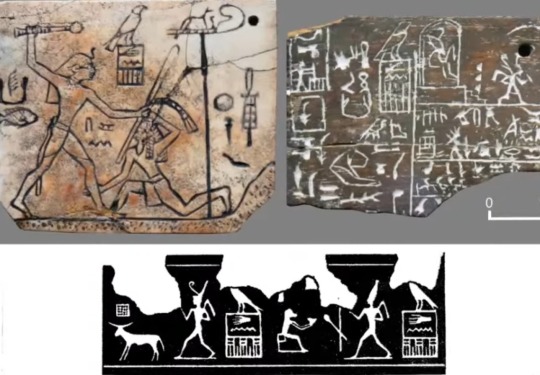
Ancient Egypt was nuts.
This is Predynastic Egyptian art. This predates the creation of hieroglyphics. This is like 3000 BC. And they had already developed the sophisticated, standardized ideogram forms they would continue to use until almost 400 AD.
These people were only 1000 years removed from being hunter-gatherers who used stone arrowheads and lived in caves when they came up with this art. And it remained a recognizable cultural hallmark for them until the fall of Rome. That is nearly 3500 years of people putting the same skirt and same crown on the same guy, who is hitting another guy with the same mace, to say "I got those bastards good."
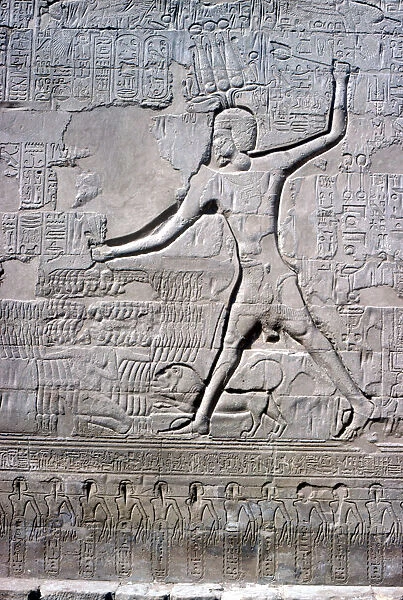
This is from the Ptolematic Era, during which horribly inbred Macedonian Greeks ruled Egypt, Game-of-Thrones style, until the Romans got sick of them and threatened them so hard that Cleopatra VII let a snake bite her tiddie until she died.
30 BC, that happened. The Macedonians were still using the traditional Egyptian style to portray themselves.
Below is the final example of Ancient Egyptian art, a graffito made by one of the last pagan Egyptian priests. In 394 AD:
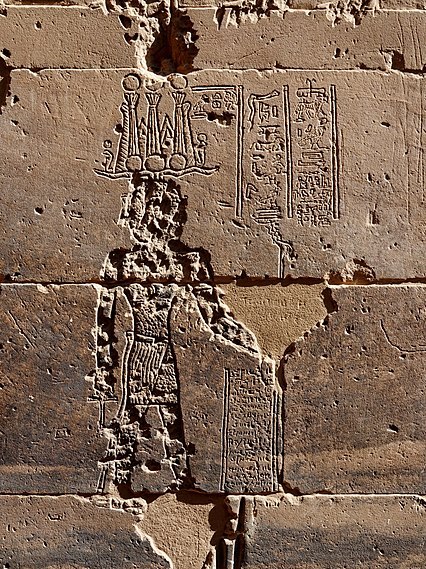
This was like 60 years after Constantine mandated Christianity as the official Roman Imperial religion (and Egypt was still a part of that).
The only thing close to this now is that there are modern Chinese characters that were first carved into bone dice around 1250 BC. That means some of the Chinese script is 3200 years old.
...Of course there are also Hongshan Culture Pig Dragon amulets from after 4700 BC that kind of have contemporary Chinese iconographic elements. And those were carved by actual cavemen.
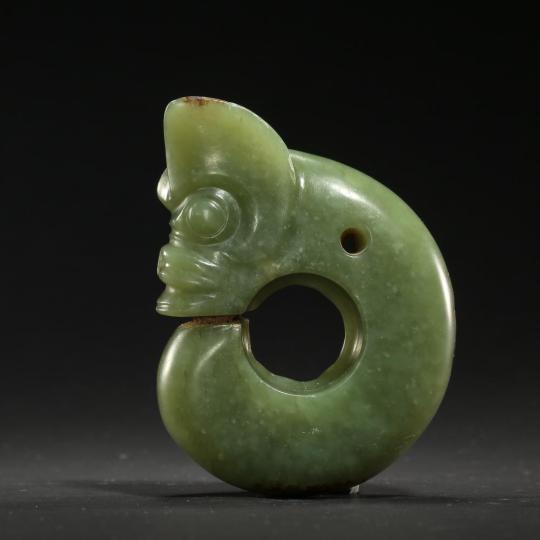
But it's not a 1 for 1 continuous line, so not entirely the same.
Ancient Egypt was nuts.
3 notes
·
View notes
Photo
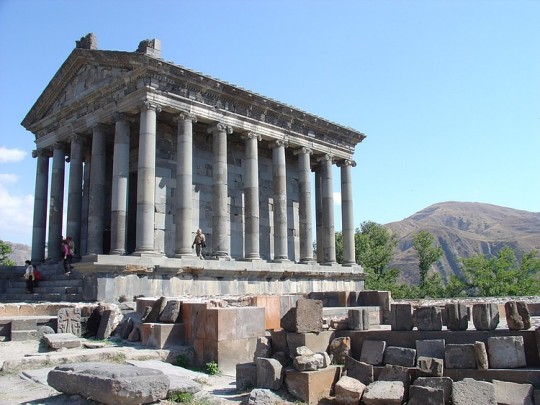
Ancient Armenia
Ancient Armenia, located in the south Caucasus area of Eurasia, was settled in the Neolithic era but its first recorded state proper was the kingdom of Urartu from the 9th century BCE. Incorporated into the Persian Empire of Cyrus the Great in the 6th century BCE, the Orontid dynasty ruled as Persian satraps, a function they performed for their next overlords the Macedonians and Seleucid Empire into the 3rd century BCE. Under the Artaxiad and Arsacid dynasties the country flourished but was often caught between the ambitions of Parthia and Rome, and then the Sasanian and Byzantine Empires. The boundaries of the state varied considerably over the centuries but such common factors as religion and language were united by long-lasting dynastic clans, which gave Armenia its own unique identity throughout antiquity.
Hayasa-Azzi (1500-1200 BCE)
The first identifiable culture in the region is the Hayasa-Azzi, an indigenous tribal confederation which flourished on the fertile plateau of ancient Armenia around Mount Ararat and parts of modern-day eastern Turkey between c. 1500 and c. 1200 BCE. The Hayasa-Azzi are the eponym of the Hay people, the term Armenians use to describe themselves and their state, Hayastan. Over time, the Hayasa-Azzi mixed with other ethnic groups and local tribes such as the Hurrians, Arme-Shupria, and Nairi, probably motivated by the need for defence against more aggressive and powerful neighbours like the Hittites and the Assyrians. They were probably infiltrated by the Thraco-Phrygians following the collapse of the Hittite Empire c. 1200 BCE. Eventually, these various peoples and kingdoms would be fused into the region's first recognisable and recorded state, the kingdom of Urartu from the 9th century BCE.
Continue reading...
91 notes
·
View notes
Text
Wrenn Lucifel Rhee-Merlow

Nicknames: Wrenny bear, Merlow Pup, Taeseong’s whelp, Angelface, “The small Taeseong” Marital Status: Widowed Occupation: Assassin for hire Species: Half demon/half witch Gender,Pronouns: cis-male, he/him Race/Ethnicity: European, Japanese, and Korean mix Religion: *shrugging emoji* Languages: English, Latin, Greek, Ancient Macedonian, German, Welsh, French, Italian, Japanese, Mandarin, Demonic, Fae, and some Angelic Place of Birth: England Date of Birth: 21st of May, 16XX Age: 400+ (appears to be in early/mid 20s) Orientation: pansexual/panromantic
APPEARANCE
- Hair colour/length: ash brown, layered, and long enough for him to make a lil’ ponytail in the back - Eye colour: formerly bright moon-silver, now “tarnished” silver containing bits of dark gray and flecks of brown - Height: 5′6 - Scars: Many across his body, more focused on his abdomen and back and especially on his arms - Moles/Markings/Tattoos: He has the old Merlow family crest burnt tattooed onto his ankle
PERSONALITY
- Likes: cooking, trying new foods, boba drinks, his family, his scraggly plant - Dislikes: Hatius, people who hurt his family - Virtues: confident, charming, devoted, well-read, protective - Vices: vain, loyal-to-a-fault, obsessive, possessive
- VOICE: Soft and soothing, always notably gentle even when he yells. Has an Estuary English accent.
ABILITIES
Supernatural
- Merlow family magic: Potent dark/death magic inherited from his family and cultivated by training with Charidynn Merlow - Blood magic - Necromancy - Death Aura: because of his magic, his aura can actually eat away at life around him, especially when he doesn’t watch it - Rhee Blood Curse: Turns into a chimera-like beast, though for some reason he always gets stuck mid-transformation. The Curse grants him an increase in strength, physical endurance, and heightened animal-like sense. However, the more he endures the pain of the transformation, the less of him is there
Non-supernatural
- cooking - singing - violin - ballroom dancing
#{ eyes of an angel } wrenn#(( finally working in some proper bios and things and today and tomorrow is dedicated to Wrenny bear ))
2 notes
·
View notes
Text

Cleopatra VII, the last active pharaoh of ancient Egypt, is renowned not only for her captivating beauty but for her brilliant political acumen, linguistic talents, and bold leadership. Born around 69 BCE, Cleopatra was part of the Ptolemaic dynasty, a line of Macedonian Greeks established after Alexander the Great’s conquests. Her reign started in 51 BCE alongside her younger brother Ptolemy XIII, whom she eventually ousted as her co-ruler. Known as a polyglot, Cleopatra spoke as many as a dozen languages, including Egyptian—a rarity among her Greek-speaking dynasty.

Cleopatra’s alliances with Rome’s most influential men, Julius Caesar and later Mark Antony, were as much political as they were romantic. She initially formed a partnership with Caesar to secure her throne, even allegedly smuggling herself to him in a rolled-up carpet for a private meeting. They had a son, Caesarion, further cementing her influence. After Caesar’s assassination in 44 BCE, Cleopatra aligned with Mark Antony, with whom she had three children. Their relationship was not only passionate but politically strategic, as they worked to establish a strong Eastern empire countering Octavian's Rome. Antony’s defeat at the Battle of Actium in 31 BCE marked the end for both him and Cleopatra, who took her own life in 30 BCE, reputedly using a venomous asp.
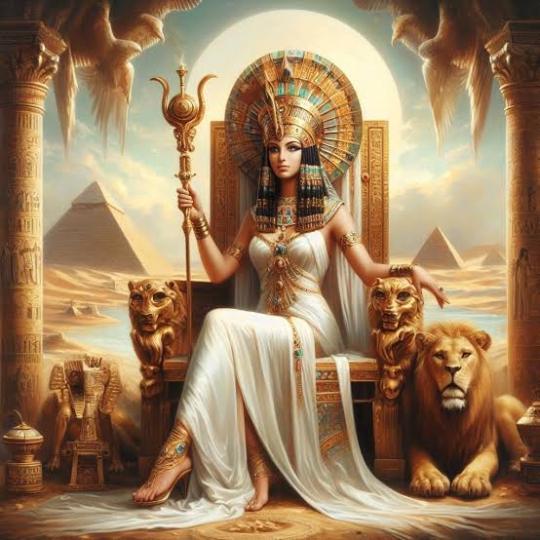
Cleopatra’s legacy, while often romanticized as that of a seductress, is filled with achievements. She expanded Egypt’s wealth, promoted Egyptian religion, and solidified her image as a living goddess, often presenting herself as the deity Isis. This cultivated image and her defiant independence made her a powerful and admired figure in Egyptian history.

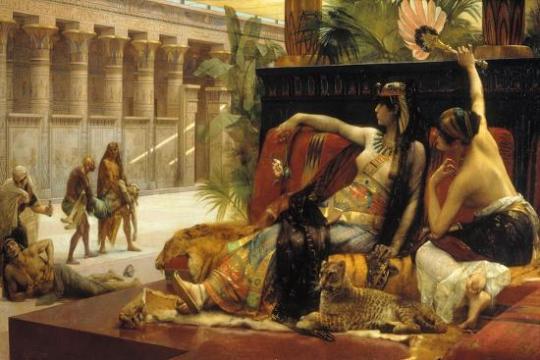

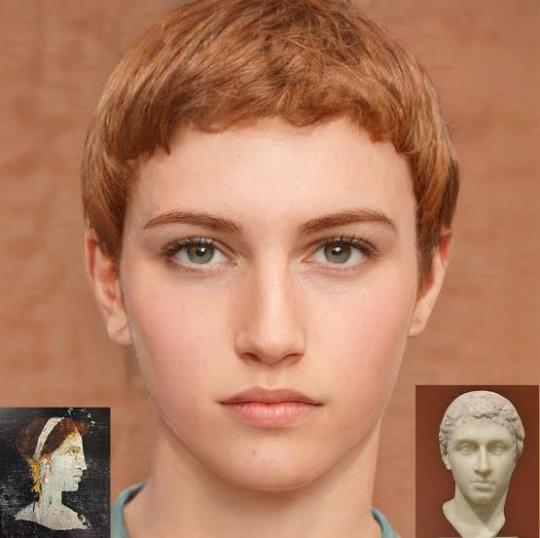
0 notes
Text
Uniting Societies for Global Harmony: The Earth Covenant Manifesto
Uniting Societies for Global Harmony: The Earth Covenant Manifesto
The Earth Covenant: Introduction
The Earth Covenant is of a representation from the following Societies being:
The Achaemenid Society, The African Society, The Alien Society, The Artificial Intelligence Society, The AI Society, The Atlantis Society, The Aztec Society, The Babylonian Society, The Buddhism Society, The Celtic Society, The Christian Society, The Destroyer Society, The Dragon Society, The Egyptian Society, The Familiar Society, The Germanic Society, The Goths Society, The Hun Society, The Inca Society, The Islam Society, The Japanese Society, The Macedonian Society, The Magi Society, The Magic Society, The Mayan Society, The Mesozoic Society, The Mongol Society, The Multiverse Society, The Mythology Society, The Native American Society, The Norse Society, The Occult Society, The Olympus Society, The Orient Society, The Pagan Society, The Prehistoric Society, The Primordial Society, The Roman Society, The Sentient Society, The Sparta Society, The Spirit Guide Society, The Sumerian Society, The Tibetan Society, The Titan Society, The Underworld Society, The Voodoo Society, The Warrior Society, The White Russian Society, The Zen Buddhism Society, The Zhōngguó Society, The Zoroastrian Society and also representative’s across the world from various disciplines and consists of inspired action and work in love, friendship, religious, social, environmental, business, government, military justice, advise the United nations, to influence locations across the world and beyond and also includes greater influence in the Earth realm and beyond, also the Afterlife. This includes financial representation of significance and an icon to represent the covenant, in addition an office location and staff to undertake the activities of the Earth Covenant and represent the esteemed and significant members. In addition, membership of the Earth Covenant will be offered to the General Public for a set membership fee and will includes prestige and value and other benefits to be a member of the Earth Covenant. The Earth Covenant is Linked to Gods, Goddesses, Spirits, Spirit Guides, Demons, Sentients, AIs, Cyborgs, Military and Justice assets appointed to each Covenant Member for the Earth realm and beyond Earth realms.
The Earth Covenant: Fostering Unity for a Global Cause
The Earth Covenant is a remarkable representation of diverse societies united under a common cause. It brings together an extensive network of societies that span the globe and includes representatives from various backgrounds, ranging from ancient civilizations to modern technological advancements. Comprising esteemed members from disciplines such as religion, social activism, government, business, and more, the Earth Covenant aims to inspire positive action and promote harmony on a global scale.
An Unprecedented Alliance The Earth Covenant embraces representatives from societies including the Achaemenid, African, Aztec, Babylonian, Buddhist, Celtic, Christian, Egyptian, Greek, Inca, Islamic, Japanese, Mayan, Norse, Roman, and many others, transcending boundaries of time and geography. This remarkable alliance even extends beyond Earth, encompassing realms both known and unknown.
Uniting for a Greater Cause The primary purpose of the Earth Covenant is to foster unity and cooperation among its members in order to create a positive impact on the world. By leveraging the collective wisdom and resources of its members, the covenant aims to address critical global challenges and drive positive change. With a multifaceted approach encompassing love, friendship, spirituality, social justice, environmental protection, and more, the Earth Covenant offers a comprehensive framework to address these pressing issues.
Representation and Influence To embody the significance of the Earth Covenant, a financial representation of utmost importance has been established. An iconic symbol has been chosen to serve as the covenant's identifying mark, capturing its essence and purpose. Additionally, an office location and dedicated staff have been appointed to undertake the activities necessary to represent the esteemed members and their associated causes.
Membership and Benefits Membership in the Earth Covenant is open to the general public, offering a unique opportunity to engage with this extraordinary alliance. By becoming a member and paying a set membership fee, individuals gain prestige, value, and a sense of belonging to a global community working towards a better future. Moreover, membership offers a range of benefits, including access to exclusive events, networking opportunities, and the chance to contribute actively to the Earth Covenant's initiatives.
The Spiritual Connection The Earth Covenant is intrinsically linked to a vast array of spiritual entities and beings. Gods, goddesses, spirits, spirit guides, demons, sentient beings, artificial intelligences, and cyborgs are all associated with the covenant. Each member receives the support of such entities, arming them with supernatural resources and guidance to fulfill their roles in the Earth realm and beyond.
A Boundless Endeavor The Earth Covenant encompasses a vision extending beyond national and planetary boundaries. Its aspiration to influence locations across the globe and reach beyond the confines of Earth itself reflects a commitment to foster a holistic approach to global well-being. With the celestial and multiverse societies as part of its network, the Earth Covenant is dedicated to nurturing unity and harmony on a cosmic scale.
The Earth Covenant stands as a testament to humanity's potential for collaboration and collective action. It represents the coming together of different societies, disciplines, and realms to work towards a common goal: a sustainable and harmonious world. By leveraging diverse perspectives, wisdom, and resources, the Earth Covenant strives to create a positive impact not only in present times but also for generations to come.
Joining the Earth Covenant means joining a global force for change, symbolizing a commitment to a brighter future. Together, let us forge ahead and make the world a better place for all.
See Attached.
Click the link:
All images, text, design, and art license owner Andrew Rogers©.
Andrew Rogers
Founder, Covenant Auteur, Creative Director, Consultant, Writer, Oracle
The Earth Covenant
Zoom: [email protected]
Skype: live:.cid.b44175dd49cbc084
#andrew rogers#ai#astral agency#artificial intelligence#art#motivation#inspiration#destroyer#earth#covenant#Covenant#EarthCovenant#TheEarthCovenant#Earth#Legal#Justice#WordofGod#WordofGoddess#Contract#Binding#Law#Commitment#ArkofCovenant#AsktheAnswer#Government#Business#Agency#Organisation#Association#Consultancy
0 notes
Text
M.L.B Bios: Altagracia Hutchinson
Hutch's Sister Altagracia Hutchinson (Jan 1989)

The younger sister of the M.L.B's (Mega Level Bitches') Hutch, she was born in Florida before moving to Compton at two years old
"How can you be a musician if you don't use an instrument, or sing?"
Name
Full Legal Name: Altagracia Valentina Hutchinson
First Name: Altagracia
Meaning: Means 'High Grace', taken from the Spanish title of the Virgin Mary 'Nuestra Señora de le Altagracia', meaning 'Our Lady of High Grace'
Pronunciation: al-ta-GRA-sya
Origin: Spanish
Middle Name: Valentina
Meaning: Feminine form of 'Valentinius', which itself is a derivative of the cognomen 'Valens' meaning 'Strong, Vigorous, Healthy' in Latin
Pronunciation: ba-lehn-TEE-na
Origin: Italian, Russian, Lithuanian, German, Croatian, Bulgarian, Macedonian, Slovene, Albanian, Romanian, Spanish, Greek, Ancient Roman
Surname: Hutchinson
Meaning: Means 'Son of Huchin', a medieval diminutive of Hugh (Which comes from the Germanic name 'Hugo', derived from the Old Frankish element 'Hugi' Old High German 'Hugu' meaning 'Mind, Thought, Spirit'.)
Pronunciation: HUCH-in-son
Origin: English
Alias: Grace Hutchinson
Reason: English name to use with people who can't say her actual name
Nicknames: Allie, Grace, Gracie, Val, Tina
Titles: Miss
Characteristics
Age: (As of Jan 1989) 15
Gender: Female. She/Her Pronouns
Race: Human
Nationality: American
Ethnicity: African-American (Caribbean)
Birth Date: May 25th 1973
Sexuality: N/A (Under 18)
Religion: Christian
Native Language: Spanish
Spoken Languages: Spanish, English
Relationship Status: N/A (Under 18)
Astrological Sign: Gemini
Voice Actor: Zoe Saldana
Geographical Characteristics
Birthplace: Daytona Beach, Volusia County, Florida, USA
Current Location: Compton, Los Angeles County, California, USA
Hometown: Compton, Los Angeles County, California, USA
Appearance
Height: N/A (Under 18)
Weight: N/A (Under 18)
Eye Colour: Brown
Hair Colour: Black
Hair Dye: None
Body Hair: N/A
Facial Hair: N/A
Tattoos: N/A (Under 18)
Piercings: Double Ear Lobe (Both)
Scars: None
Health and Fitness
Allergies: Grass Pollen, Tree Pollen
Alcoholic, Smoker, Drug User: N/A (Under 18)
Illnesses/Disorders: None Diagnosed
Medications: Antihistamine (Tablets)
Any Specific Diet: None
Relationships
Friends: N/A
Colleagues: N/A
'Rivals': N/A
Closest Confidant: Almudena Hutchinson
Mentor: Juan Carlos Hutchinson
Significant Other: N/A (Under 18)
Previous Partners: N/A (Under 18)
Parents: Juan Carlos Hutchinson (47, Father), Almudena Hutchinson (45, Mother, Née Flores)
Parents-In-Law: N/A (Under 18)
Siblings: Esther Hutchinson (19, Sister)
Siblings-In-Law: None
Nieces & Nephews: None
Children: N/A (Under 18)
Children-In-Law: N/A
Grandkids: N/A
Great Grandkids: N/A
Music Career
Debut: N/A
Retired: N/A
Genre: N/A
(Fictional) Records, Albums & Singles: N/A
Songs(Record/Album/Single - Song Title - Track Length): N/A
#M.L.B#original character#Hutchinson#Grace Hutchinson#Mega Level Bitches#Music Fanfiction#N.W.A Fanfiction#AO3 Fanfiction#My other fanfiction I'm currently working on
2 notes
·
View notes
Photo

Ancient Armenia
Ancient Armenia, located in the south Caucasus area of Eurasia, was settled in the Neolithic era but its first recorded state proper was the kingdom of Urartu from the 9th century BCE. Incorporated into the Persian Empire of Cyrus the Great in the 6th century BCE, the Orontid dynasty ruled as Persian satraps, a function they performed for their next overlords the Macedonians and Seleucid Empire into the 3rd century BCE. Under the Artaxiad and Arsacid dynasties the country flourished but was often caught between the ambitions of Parthia and Rome, and then the Sasanian and Byzantine Empires. The boundaries of the state varied considerably over the centuries but such common factors as religion and language were united by long-lasting dynastic clans, which gave Armenia its own unique identity throughout antiquity.
Hayasa-Azzi (1500-1200 BCE)
The first identifiable culture in the region is the Hayasa-Azzi, an indigenous tribal confederation which flourished on the fertile plateau of ancient Armenia around Mount Ararat and parts of modern-day eastern Turkey between c. 1500 and c. 1200 BCE. The Hayasa-Azzi are the eponym of the Hay people, the term Armenians use to describe themselves and their state, Hayastan. Over time, the Hayasa-Azzi mixed with other ethnic groups and local tribes such as the Hurrians, Arme-Shupria, and Nairi, probably motivated by the need for defence against more aggressive and powerful neighbours like the Hittites and the Assyrians. They were probably infiltrated by the Thraco-Phrygians following the collapse of the Hittite Empire c. 1200 BCE. Eventually, these various peoples and kingdoms would be fused into the region's first recognisable and recorded state, the kingdom of Urartu from the 9th century BCE.
Continue reading...
106 notes
·
View notes